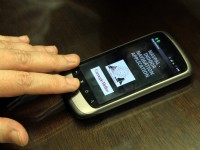Safe and independent navigation of urban environments is a key feature of accessible cities. People who have physical challenges need practical, customizable, low-cost and easily-deployable mobility aids to help them safely navigate urban environments. Technology tools provide opportunities to empower people with disabilities to overcome some day-to-day challenges.
Our NavPal project focuses on enhancing the navigation capability and thereby the independence and safety of visually impaired and deafblind people. The original goal of the project was to design, implement, test, and deploy a smartphone-based personalized aid. After more completely understanding the needs of visually impaired adults, and having developed and tested an initial prototype of the smartphone application for NavPal, we learned that dynamic feedback during navigation alone was insufficient to empower blind travelers to safely and independently navigate urban environments. Therefore, the goals of this project have now expanded to develop a suite of tools to support urban navigation for blind travelers. Work to date on the NavPal project has resulted in three primary technology tools:
1. A smartphone app to give navigational assistance to blind adults as they move around unfamiliar indoor environments
2. An accessible online tool that allows blind adults to pre-plan routes in an unfamiliar indoor environment
3. An online software tool for creating and editing building maps such that they can be easily made accessible to blind travelers.
All of these tools have been shared with a variety of audiences through informal presentations, and both undergraduate and graduate students have been engaged in the needs assessment, design, implementation, and user testing of these tools. Pictured: NavPal smartphone application
The NavPal project is being expanded to enhance safety for visually impaired travelers using public transit stations. Day-to-day activities such as using transit systems remain challenging tasks for people with visual impairments even though the use of transit systems is often a key factor for participation in employment, educational, social, and cultural opportunities. Through this work, we will be exploring the specific challenges encountered by visually impaired travelers when navigating in and around transit stations, and examine several technology options for enhancing safety for this population during their use of transit stations.
current head
past staff
- Sarah M Belousov
- Malcolm Frederick Dias
- Balajee Kannan
- Byung-Cheol Min
- Ermine A Teves
past contact
- Ermine A Teves

